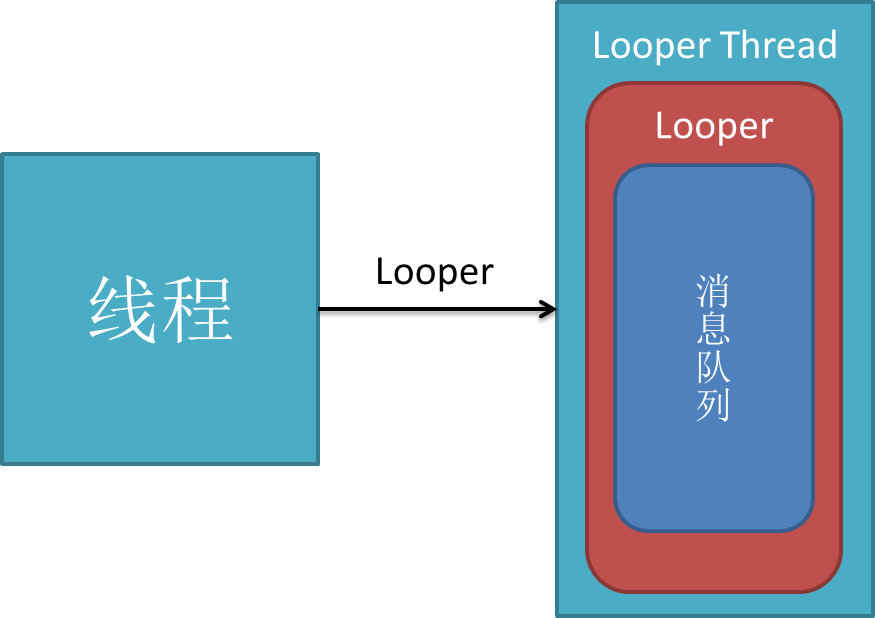Looper
Looper是线程用来运行消息循环(message loop)的类。默认情况下,线程并没有与之关联的Looper,可以通过在线程中调用Looper.prepare() 方法来获取,并通过Looper.loop() 无限循环地获取并分发MessageQueue中的消息,直到所有消息全部处理。典型用法如下:
1 public class LooperThread extends Thread { 2 @Override 3 public void run() { 4 // 将当前线程初始化为Looper线程 5 Looper.prepare(); 6 7 // ...其他处理,如实例化handler 8 9 // 开始循环处理消息队列 10 Looper.loop(); 11 } 12 }
通过上面两行核心代码,你的线程就升级为Looper线程了
1)Looper.prepare()

通过上图可以看到,现在你的线程中有一个Looper对象,它的内部维护了一个消息队列MessageQueue。一个Thread只能有一个Looper对象
1 public class Looper { 2 // 每个线程中的Looper对象其实是一个ThreadLocal,即线程本地存储(TLS)对象 3 private static final ThreadLocal sThreadLocal = new ThreadLocal(); 4 // Looper内的消息队列 5 final MessageQueue mQueue; 6 // 当前线程 7 Thread mThread; 8 // 。。。其他属性 9 10 // 每个Looper对象中有它的消息队列,和它所属的线程 11 private Looper() { 12 mQueue = new MessageQueue(); 13 mRun = true; 14 mThread = Thread.currentThread(); 15 } 16 17 // 我们调用该方法会在调用线程的TLS中创建Looper对象 18 public static final void prepare() { 19 if (sThreadLocal.get() != null) { 20 // 试图在有Looper的线程中再次创建Looper将抛出异常 21 throw new RuntimeException("Only one Looper may be created per thread"); 22 } 23 sThreadLocal.set(new Looper()); 24 } 25 // 其他方法
通过源码,prepare()背后的工作方式一目了然,其核心就是将looper对象定义为ThreadLocal。如果你还不清楚什么是ThreadLocal,请参考《理解ThreadLocal》
2)Looper.loop()

调用loop方法后,Looper线程就开始真正工作了,它不断从自己的MQ中取出队头的消息(也叫任务)执行。其源码分析如下:
1 public static final void loop() { 2 Looper me = myLooper(); //得到当前线程Looper 3 MessageQueue queue = me.mQueue; //得到当前looper的MQ 4 5 // 这两行没看懂= = 不过不影响理解 6 Binder.clearCallingIdentity(); 7 final long ident = Binder.clearCallingIdentity(); 8 // 开始循环 9 while (true) { 10 Message msg = queue.next(); // 取出message 11 if (msg != null) { 12 if (msg.target == null) { 13 // message没有target为结束信号,退出循环 14 return; 15 } 16 // 日志。。。 17 if (me.mLogging!= null) me.mLogging.println( 18 ">>>>> Dispatching to " + msg.target + " " 19 + msg.callback + ": " + msg.what 20 ); 21 // 非常重要!将真正的处理工作交给message的target,即后面要讲的handler 22 msg.target.dispatchMessage(msg); 23 // 还是日志。。。 24 if (me.mLogging!= null) me.mLogging.println( 25 "<<<<< Finished to " + msg.target + " " 26 + msg.callback); 27 28 // 下面没看懂,同样不影响理解 29 final long newIdent = Binder.clearCallingIdentity(); 30 if (ident != newIdent) { 31 Log.wtf("Looper", "Thread identity changed from 0x" 32 + Long.toHexString(ident) + " to 0x" 33 + Long.toHexString(newIdent) + " while dispatching to " 34 + msg.target.getClass().getName() + " " 35 + msg.callback + " what=" + msg.what); 36 } 37 // 回收message资源 38 msg.recycle(); 39 } 40 } 41 }
除了prepare()和loop()方法,Looper类还提供了一些有用的方法,比如
Looper.myLooper()得到当前线程looper对象:
1 public static final Looper myLooper() { 2 // 在任意线程调用Looper.myLooper()返回的都是那个线程的looper 3 return (Looper)sThreadLocal.get(); 4 }
getThread()得到looper对象所属线程:
1 public Thread getThread() { 2 return mThread; 3 }
Handler 避免内存泄漏
- handler.removeCallbacksAndMessages(null);
- handler.getLooper().quit();
Looper的quit()方法结束looper循环:
public final class Looper {// sThreadLocal.get() will return null unless you've called prepare(). static final ThreadLocal<Looper> sThreadLocal = new ThreadLocal<Looper>(); private static Looper sMainLooper; // guarded by Looper.class final MessageQueue mQueue; public void quit() { mQueue.quit(false);//调用MessageQueue退出 }
}
MessageQueue 的quit()方法
public final class MessageQueue { //... void quit(boolean safe) { if (!mQuitAllowed) { throw new IllegalStateException("Main thread not allowed to quit."); } synchronized (this) { if (mQuitting) { return; } mQuitting = true; if (safe) { removeAllFutureMessagesLocked(); } else { removeAllMessagesLocked(); } // We can assume mPtr != 0 because mQuitting was previously false. nativeWake(mPtr); } } private void removeAllMessagesLocked() { Message p = mMessages; while (p != null) { Message n = p.next; p.recycleUnchecked(); p = n; } mMessages = null; } private void removeAllFutureMessagesLocked() { final long now = SystemClock.uptimeMillis(); Message p = mMessages; if (p != null) { if (p.when > now) { removeAllMessagesLocked(); } else { Message n; for (;;) { n = p.next; if (n == null) { return; } if (n.when > now) { break; } p = n; } p.next = null; do { p = n; n = p.next; p.recycleUnchecked(); } while (n != null); } } } //... }
通过观察以上源码我们可以发现:
当我们调用Looper的quit方法时,实际上执行了MessageQueue中的removeAllMessagesLocked方法,该方法的作用是把MessageQueue消息池中所有的消息全部清空,无论是延迟消息(延迟消息是指通过sendMessageDelayed或通过postDelayed等方法发送的需要延迟执行的消息)还是非延迟消息。
当我们调用Looper的quitSafely方法时,实际上执行了MessageQueue中的removeAllFutureMessagesLocked方法,通过名字就可以看出,该方法只会清空MessageQueue消息池中所有的延迟消息,并将消息池中所有的非延迟消息派发出去让Handler去处理,quitSafely相比于quit方法安全之处在于清空消息之前会派发所有的非延迟消息。
无论是调用了quit方法还是quitSafely方法只会,Looper就不再接收新的消息。即在调用了Looper的quit或quitSafely方法之后,消息循环就终结了,这时候再通过Handler调用sendMessage或post等方法发送消息时均返回false,表示消息没有成功放入消息队列MessageQueue中,因为消息队列已经退出了
到此为止,你应该对Looper有了基本的了解,总结几点:
1.每个线程有且最多只能有一个Looper对象,它是一个ThreadLocal
2.Looper内部有一个消息队列,loop()方法调用后线程开始不断从队列中取出消息执行
3.Looper使一个线程变成Looper线程。
handler
什么是handler?handler扮演了往MQ上添加消息和处理消息的角色(只处理由自己发出的消息),即通知MQ它要执行一个任务(sendMessage),并在loop到自己的时候执行该任务(handleMessage),整个过程是异步的。handler创建时会关联一个looper,默认的构造方法将关联当前线程的looper,不过这也是可以set的。默认的构造方法:
public class handler { final MessageQueue mQueue; // 关联的MQ final Looper mLooper; // 关联的looper final Callback mCallback; // 其他属性 public Handler() { // 没看懂,直接略过,,, if (FIND_POTENTIAL_LEAKS) { final Class extends Handler> klass = getClass(); if ((klass.isAnonymousClass() || klass.isMemberClass() || klass.isLocalClass()) && (klass.getModifiers() & Modifier.STATIC) == 0) { Log.w(TAG, "The following Handler class should be static or leaks might occur: " + klass.getCanonicalName()); } } // 默认将关联当前线程的looper mLooper = Looper.myLooper(); // looper不能为空,即该默认的构造方法只能在looper线程中使用 if (mLooper == null) { throw new RuntimeException( "Can't create handler inside thread that has not called Looper.prepare()"); } // 重要!!!直接把关联looper的MQ作为自己的MQ,因此它的消息将发送到关联looper的MQ上 mQueue = mLooper.mQueue; mCallback = null; } // 其他方法 }
这里有一个疑问,如果handler在主线程的死循环一直运行是不是特别消耗CPU资源呢?
这里就涉及到Linux pipe/epoll机制,简单说就是在主线程的MessageQueue没有消息时,便阻塞在loop的queue.next()中的nativePollOnce()方法里,此时主线程会释放CPU资源进入休眠状态,直到下个消息到达或者有事务发生,通过往pipe管道写端写入数据来唤醒主线程工作。这里采用的epoll机制,是一种IO多路复用机制,可以同时监控多个描述符,当某个描述符就绪(读或写就绪),则立刻通知相应程序进行读或写操作,本质同步I/O,即读写是阻塞的。 所以说,主线程大多数时候都是处于休眠状态,并不会消耗大量CPU资源。
下面我们就可以为之前的LooperThread类加入Handler:
1 public class LooperThread extends Thread { 2 private Handler handler1; 3 private Handler handler2; 4 5 @Override 6 public void run() { 7 // 将当前线程初始化为Looper线程 8 Looper.prepare(); 9 10 // 实例化两个handler 11 handler1 = new Handler(); 12 handler2 = new Handler(); 13 14 // 开始循环处理消息队列 15 Looper.loop(); 16 } 17 }

可以看到,一个线程可以有多个Handler,但是只能有一个Looper!